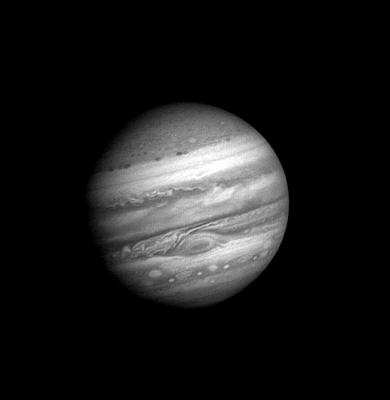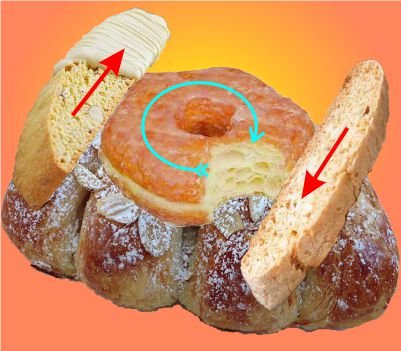The Al’s Coffee Shop Astronomy gang is still discussing Jupiter’s Great Red Spot. Cathleen‘s holding court, which is natural because she’s the only for-real Astronomer in the group… “So here’s what we’ve got. The rim of the Great Red Spot goes hundreds of miles an hour in the wrong direction compared to hurricanes on Earth. An Earth hurricane’s eye is calm but the Jupiter Spot’s rim encloses a complex pattern of high winds. Heat transport and cloud formation on Earth are dominated by water, but Jupiter’s atmospheric dynamic has two active players — water and ammonia.”
“Here’s your pastries, Cathleen. I brought you a whole selection. Don’t nobody sneeze on ’em, OK?”
“Oh, they’re perfect, Al. Thanks. Let’s start with this bear claw. We’ll pretend it’s the base of the weather column. On Earth that’d be mostly ocean, some land surface and some ice. They’re all rough-ish and steer air currents, which is why there’s a rain shadow inland of coastal mountain ranges.”
“Jupiter doesn’t have mountains?”
“We’re virtually certain it doesn’t, Sy. The planet’s density is so low that it can’t have much heavy material. It’s essentially an 88,000-mile-wide ball of helium-diluted liquid hydrogen topped by a 30-mile-high weather column. Anything rocky sank to the core long ago. The liquid doesn’t even have a real surface.”
<Al and Sy> “Huh?”
“Jovian temps are so low that even at moderate pressures there’s no boundary between gaseous and liquid phases. Going downward you dive through clear ‘air,’ then progress through an increasingly opalescent haze until you realize you’re swimming. Physicists just define the ‘surface’ to be the height where the pressure is one atmosphere. That level’s far enough down that water and ammonia freeze to form overlying cloud layers but hydrogen and helium are still gases. It could conceivably look like home there except the sky would be weird colors and you don’t see a floor.”
“If the boundary is that blurry, it’s probably pretty much frictionless — weather passes over it without slowing down or losing energy, right?”
“Yup.”
“So there’s way too much slivered almonds and stuff on that bear claw. On this scale it ought to have a mirror finish.”
“Good point. But now we can start stacking weather onto it. Here’s my doughnut, to represent the Great Red Spot or any of the other long-lived anticyclones.”
“Auntie who?”
“A-n-t-i-cyclone, Al. Technical term for a storm that disobeys the Coriolis theory.”
“Uh-HUH. So why’s it do that?”
“Well, at this point we can only go up one level in the cause-and-effect chain. <pulling out smartphone> NASA’s Voyager 1 spacecraft sent back data for this this wonderful video

“Basically, the Spot is trapped between two jet streams, one going westward at 135 mph and the other going eastward at 110 mph. I’ll use these biscotti to represent them.
“Hey, that’s like a rack-and-pinion gear setup, with two racks and an idler, except the idler gear’s four times as wide as the Earth.”
“A bit less than that these days, Sy. The Spot’s been shrinking and getting rounder. Every year since 1980 it’s lost about 300 miles east-west and about 60 miles north-south. As of 2014 it was about 2.8 Earth-widths across. And no, we don’t know why. Theories abound, though.”
“What’s one of them?”
“Believe it or not, climate change. On Jupiter, not Earth. One group of scientists at Berkeley tackled a couple of observations
- Unlike Earth, which is much hotter near the Equator than near the poles, Jupiter’s Equator is only a few degrees warmer than its poles.
- Three persistent White Ovals near the Great Red Spot merged to form a single White Oval that recently turned red but only around the edges.
Their argument is long, technical and still controversial. However, their proposal is that merging the three ovals disrupted the primary heat transport mechanism that had been evening out Jupiter’s temperature. IF that’s true, and if it’s the case that Jupiter’s jet streams are powered by heat transport, then maybe disrupted heat patterns are interfering with the Great Red Spot’s rack-and-pinion machine. And maybe more.”
“Big changes ahead for the Big Planet.”
“Maybe.”
~~ Rich Olcott


What I understand from Juno is that there are silicate molecules (perhaps from meteorite impacts) at the base of the deep atmosphere, top of the weakly conducting molecular shell. Interesting that the white ovals merge around the GRS, but those at the South pole (polar vortices) move in a semi-random way and don’t merge.
LikeLike
Interesting observations, Carol, thanks. Juno’s confirmed that Jupiter’s atmosphere is highly turbulent. On Earth we have small sand grains suspended throughout the entire water column in our oceans, despite sand being denser than water. I guess then we shouldn’t be surprised that Juno detected similar silicate particles. Now how to determine whether they’re exogenous or “wafted” up from the planet’s depths?
LikeLike